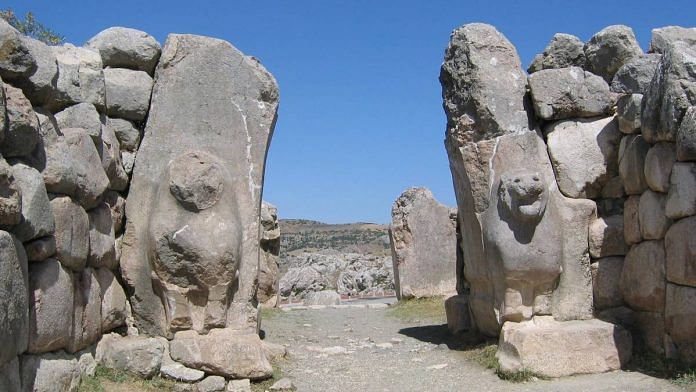New Delhi: The Hittite Empire in central Anatolia rose to be one of the major powers of the Bronze Age before its capital, Hattusa, was inexplicably abandoned by its rulers sometime around 1200 BCE — eventually leading to the empire’s fall. And as it turns out, juniper timbers at archeological sites have held the answer to this mysterious collapse for over 3,200 years.
In a study published Wednesday in the journal Nature, researchers found that a series of droughts around 1198 and 1196 BCE may have brought down the empire. The research shows how extreme climate change can push populations beyond their adaptation limits and centuries-old resilience practices.
The Hittite Empire, centred in semi-arid central Anatolia in present-day Turkey, is recognised as having been of the major powers of the Eastern Mediterranean and the Near East, flourishing between 1650 and 1200 BCE.
According to the study, the empire had long proved itself to be resilient against regular sociopolitical, economic and even environmental challenges such as the threat of drought. However, around or shortly after 1200 BCE, the empire fell. This occurred at roughly the same time as the decline of several other major civilisations, in what’s known as the Bronze Age collapse.
The end of the settlement at Hattusa has been a key topic of historical scrutiny. It was long thought that a military attack had led to the city’s downfall. However, archaeological investigations now indicate that the city was abandoned and emptied by the royal administration and only later burnt.
The team of archaeologists — including researchers from Cornell University in the USA and the Cyprus Institute in Aglandjia, Cyprus — studied tree rings of contemporary juniper trees in central Anatolia to assess the role of drought in the collapse of the Hittite Empire.
The measurement of moisture content from the tree rings helped the researchers identify an unusually severe, continuous dry period that occurred between 1198 and 1196 BCE.

According to the team, this severe drought led to long periods of food shortages. The landlocked territories of the core Hittite realm were reliant on regional grain production and animal farming, which are particularly vulnerable to drought.
These shortages would have led to political, economic and social unrest, as well as disease outbreaks, and eventually may have precipitated the collapse of the empire, the study added.
Although a 300-year shift to a drier, cooler climate around this period has been associated with the collapse of several ancient civilisations in the East Mediterranean and Near-East, the precise details of the link between climate change and events in human history are less clear.
Also read: IIT Bombay team is creating a model to study evolution of glacial lakes, predict breaking point
Drought not sole cause
For Anatolia, dry years and droughts were a regular feature, and even pairs of arid years occurred at least once a generation. However, major droughts causing serious harvest failure in consecutive years were much rarer, probably occurring only once or at most twice in a century, the study observed.
The evidence collected by the researchers suggests that a major drought and harvest reduction in central Anatolia for three consecutive years between 1198 and 1196 BCE would have challenged the empire’s existing adaptations and resilience strategies.
This drought event contributed to, but did not solely cause, the collapse of the empire.
Climate change, population movements, reorientations of trade and political fragmentation all played a part in the changes that occurred across the Old World around 1200 BCE, claimed the researchers. The vulnerability of established human systems to unexpected and consecutive multi-year extreme events can break and overwhelm established adaptations and resilience.
These extremes can overwhelm human coping mechanisms and may apply both in history and today in the face of current climate change, they said.
In a linked comment, Müge Durusu-Tanrıöver, a researcher at Temple University in the US who was not part of the study, said the study proves the presence of a major climate event, while also identifying its exact dates, a feat not previously possible.
“(The) study is groundbreaking because it finally gives us a tangible clue to why Hattusa was abandoned. Future research might discover whether the extreme climate event of 1198–1196 BCE was confined to central Anatolia or was a larger eastern Mediterranean phenomenon that can offer insight beyond the case of the Hittites,” Durusu-Tanrıöver said.
(Edited by Poulomi Banerjee)
Also read: Revolution against QR codes, robots of the future – how IIT Kanpur’s tech is changing world



